Jim Krause | Classes | P356 TV Studio Production
Week 2
Announcements/Reality Check
- Critical Viewing Exercise due today
- If you want to go to Prague or Ecuador, be sure to get your application in by tomorrow.
- Produce Studio 5 Profiles this week in lab
- No lab or lecture next week due to MLK Day, but be sure to carry out the Cybercollege readings and prepare for the first quiz (Monday, January 28).
- We still could use one or two people to move from Monday lab to Wednesday lab
- Cybercollege readings: Modules 10, 12, 13, 15, 16, 17, 18, 19, 20 & 21
Critical Viewing Wrap Up
Openings:
- Late Show with Stephen Colbert
- NBC Nightly News (News teaser)
- My Next Guest Needs No Introduction (Netflix)
- Seinfeld (credits over opening monologue)
- The Ellen Degeneres Show (starts right into opening sequence)
- Rosie O' Donnell show
Music starts strong (not fades up)
Often a pre-produced piece or teaser is used to open before the title/opening credits
Don't use music with lyrics under someone talking
Cameras:
Major parts of video cameras: lens, beam splitter, CCDs/CMOS, & viewfinder
Sensors
The lens focuses the light onto an imaging or pickup device. In the old days cameras used tubes, which were replaced by CCDs (Charge Coupled Device). Nowadays most camcorders, laptops, and phones use CMOS (Complementary Metal-Oxide Semiconductor) sensors. CMOS sensors have become more widely used as they are a bit easier to manufacture and use less power than CCDs.
Most professional video cameras use a beam splitter, which consists of prisms. The incoming light is split into its primary components, Red Green & Blue and recorded onto three separate CCD or CMOS imaging elements. These elements are about the size of a postage stamp and convert the light energy into an electric charge. While the industry norm has been to use three imaging elements, a growing number, such as the Red One, are using a large, single CMOS sensors.
Here's a nice picture of a prism block from Adam Wilt's amazing and informative website:
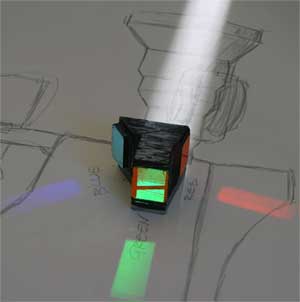
CMOS / CCD sensor sizes
Sensors are made in different sizes such as 1/4", 1/3", 1/2", 2/3", 1", 4/3" APS-C, and 35mm (full frame).
Due to the physics of optics, smaller sensors (E.g. 1/4") inherently have a larger or greater depth of field compared with larger sensors (E.g. 35mm), which have a shallower or smaller depth of field.
Consumer cameras usually have very small sensors. (1/4" for example.) As the price and quality go up, so does sensor size. DSLRs typically use APS-C or 35mm sensors. Most professional multi-camera studio cameras (like the Grass Valley LDX cameras in Studio 5) have a prism block and three 2/3" CMOS sensors.
Lens mounts are standardized and matched to the corresponding sensor size. (You'd use a 2/3" lens mount with a camera with 2/3" sensor.) The bigger the lens mount, the bigger the sensor and the more room for pixels. Generally speaking, bigger is better and the more pixels a sensor has on it the higher the resolution or detail that can be delivered by the camera.
Bandwidth & Resolution
How much detail does the camera show, or how much signal detail can we carry? Bandwidth refers to how much signal a device can carry and is typically given in megahertz (MHz). Resolution refers to how well the camera resolves the image. With the proper test charts and monitors, it's possible to measure the resolution of VCRs, TVs, and other video devices.
To determine resolution you need to use a resolution chart. The most important parameter is horizontal resolution.
Horizontal Resolution: The number of vertical lines that can be seen when placed side by side.
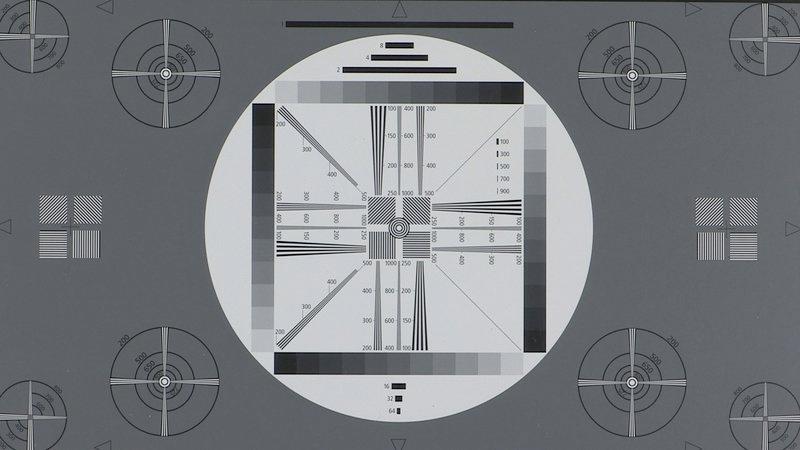 |
|
A test chart can be used to determine the camera's resolution. |
|
 |
This close up shows the chart's convergence lines. The point at which the lines are no longer individually discernable is the resolution of the camera. |
Approximate resolution of various formats.
- VHS can resolve about 240 lines
- DVDs about 400 lines
- DV about 500 lines
- HD - XDCam is about 900 lines
Sensitivity
How much light does the camera need to operate? This is called minimum illumination or sensitivity. It’s measured in foot-candles (American) or lux (European) usually along with the required f-stop and gain needed to capture an image. For example Panasonic's AJ-SDX900 reported minimum illumination is 0.01 lux (F 1.4, +48dB +20dB gain).
Aspect Ratio
The aspect ratio should always be provided in width to height. Before the advent of HD, TV was broadcast in 4:3. HD is always broadcast in 16:9.
- 4 x 3 (or 1.33:1)
- 16 x 9 (or 1.78:1) This is closer to standard widescreen movies.
Other parts of a studio camera include:
Filter wheel. It usually holds a couple of neutral density (ND) filters and a color correction filter (3200 degrees Kelvin for indoor, 5600, 5600 + 1/4 ND, etc)
Viewfinders: small video monitor mounted on top of the camera. Typically will be LCD (Liquid Crystal Display), CRT (Cathode Ray Tube) or OLED (Organic Light emitting Diode).
Tally lights: turn on when the camera is on-line
Power supply: 12 volts- conveniently the same voltage a car runs on.
Gain: The gain feature boosts the level of the video signal electronically. Since the video is "amplified", it's done so in dBs. (+3 db, +6 db, + 9 db, etc.) Turning on the gain adds noise and excessive amounts will produce noticeable graininess.
Lenses:
Focal length: the distance from the optical center of the lens to the target (CCD or film) Measured in millimeters. An 18mm lens would generally be considered a wide angle lens. A 200mm lens could be considered a telephoto lens.
Angle of view: Wide angle lenses have a wide angle of view. When you zoom in all the way to a CU you have a very small angle of view.
Zoom ratio: Most video lenses have variable zoom lenses or focal lengths. The range is the zoom ratio. You can say that a lens provides a 10:1 or a 17:1 range, but this still doesn't’t tell you much about the focal length in terms of actual numbers (how many millimeters is is?)
So to solve this zoom ratios on lenses usually have two numbers. The first refers to the minimum focal length. The second is the multiplier.
- 9.5x17 (9.5mm x 161.5mm)
- 10x10? (10 mm x 100 mm)
- 12 x 20? (12 mm x 240 mm)
- 8 x 80 (Some lenses have the mm marked as the 2nd number)
Depth of Field
Good camera operators know how to precisely control the depth of field, which is the area that is in focus. Depth of field is affected by two major factors: focal length and aperture.
Wide angle lenses (such as 20mm) will tend to have a very large depth of field. In other words when you are zoomed out to a wide shot, everything will look like it's in focus. Telephoto lenses (such as 200mm) create a much smaller depth of field. When you are zoomed in, it's much trickier to track objects, such as people, moving toward or away from the camera.
F-stop - A number that represents the size of the aperture in an inverse manner. A large f-stop corresponds to a small aperture, or opening in the iris. A small f-stop represents a large opening.
The relationship between F-stop and depth of field: The larger the f-stop (or smaller the opening) the greater your depth of field will be.
Think about this. Imagine you are in the studio zoomed in on a MCU of your talent with a chart in the background. The background is out of focus. What could you do to make it sharper?
Answer: You could add light, which would allow you to use a smaller aperture.
Part II: You are in the studio zoomed in on a MCU of your talent with a chart in the background that is distracting. You want to make the background out of focus. What could you do to create a shallower depth of field?
Answer: You could reduce the amount of light entering the camera (dim the light or engage an ND filter), which would necessitate using a larger aperture.
Selective focus - the process of using limited depth of field to throw areas of the image out of focus
Rack focus - varying the focus from one object to another
Follow focus - Keep focus on an object moving towards or away from the camera. (Separates the amateurs from the pros.)
Macro focus - an adjustable ring at the base of the lens, near where it attaches to the camera. Allows the operator to focus on items a few inches from the lens.
Auto focus - Typically not found or used on professional studio cameras.
Auto iris - automatically controls the iris to maintain the proper exposure. This can often lead to problems. If something bright enters the frame- the camera will iris down causing a noticeable darkening of the image.
Shutter speed - In the US (NTSC) the default shutter speed is 1/60 of a second. (This is the interval of a field of video.) You can see a blur in fast-moving objects. (baseballs etc) You can increase the shutter speed to capture fast-moving things better. As with still cameras, the faster the shutter speed, the more light is required.
Moiré patterns - These show up when you are shooting a small, highly contrasting pattern (E.g. a tweed jacket) The pattern of the image interacts with the pattern of the imaging pixels to create moiré patterns (usually undersirable).
Tally lights - Small lights (usually red) which indicate which camera is "live"
White Balance - When the engineer presses the WB button the camera adjusts the Red Green & Blue signals to be of equal intensity. (In the RGB color system, white is made up of equal components of red, green and blue.)
Black balance - irises the lens down all the way to black and sets the pedestal/black level at 0 IRE.
Lab------------------------
- Look at floor plans & lighting plots.
- Review rotation exercise
- Review director's and the AD's job.
- Think about where the Floor Manager should be
- Carry out rotation exercise
Designing simple floor plans and light plots.
Floor plans & lighting plots should be driven by what the producer wants to see inside the frame. In other words design your set through the eyes of the camera. Once you determine what you want to see inside the viewfinder or on the monitor, you can think about how to build and light the set to achieve the desired image.
Director/Assistant Director/Floor Director Duties & Cues
Review roles of director and assistant director.
- Both should talk clearly. (No-one else should talk unless necessary)
- Always address the person you're talking to. (Camera 1- please tilt up")
AD duties:
- Get's folks prepared. Makes sure Floor Director quiets set before shooting.
- Times the show. Counts down out loud and presses the timer start at "0". Do not rush!.
- Runs the Teleprompter
- Helps set up shots
- Keeps track of time. Knows how to backtime. Tells the director when to wrap.
- Makes sure to end timer at after fade to black.
Director duties:
- Stay calm
- When interacting with talent always make them comfortable.
- Should brief and "ready" the TD, audio, graphics, etc. BEFORE COUNTDOWN STARTS.
- Be able to say "Mic & CUE talent"
- Focus on getting good shots and a good performance.
- Should be able to look ahead and line up shots well before they are needed.
- Don't freeze. When in doubt, cut to another good shot.
- Keep directions accurate and concise. "Ready downstream key." "Ready 1....... Take 1"
- Thanks everybody at end.
Floor Director Cues (from Zettl - Chapter 16)
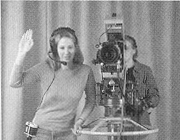 |
Standby - Show about to start |
 |
Cue - Show goes on air |
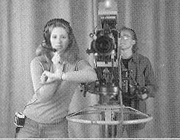 |
Half-minute - 30 seconds left in show. Can form cross with two index fingers. |
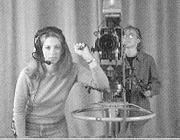 |
15 seconds - 15 seconds left in show |
 |
Cut - Stop speech or action immediately |
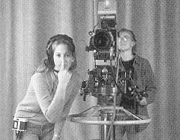 |
On time - Go ahead as planned |
 |
Roll VTR (and countdown) |
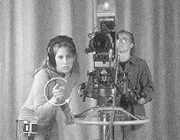 |
Speed Up - Accelerate what you are doing (You're going too slow) |
 |
Slow down - too much time left |
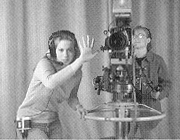 |
5, (4, 3, 2, 1) minutes left until end of show |
 |
Wind up - Finish what you are doing. Come to an end. |


